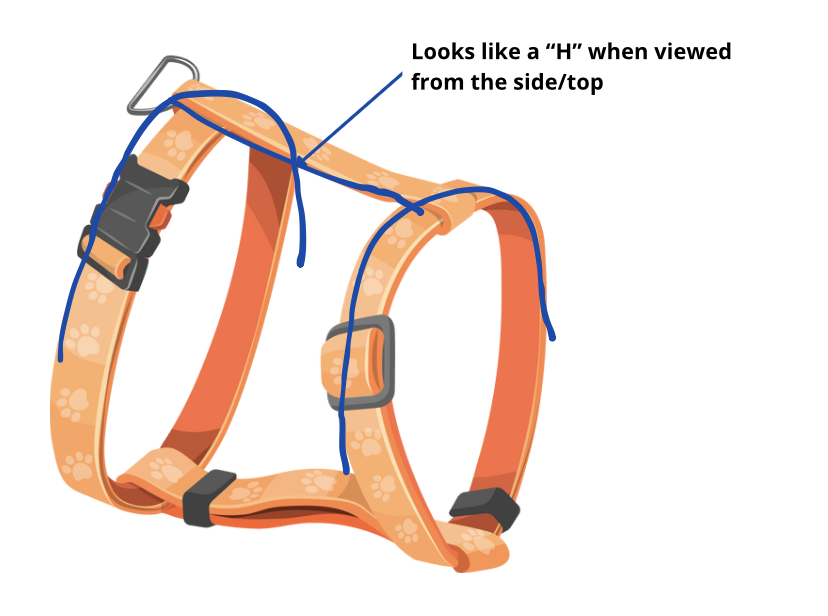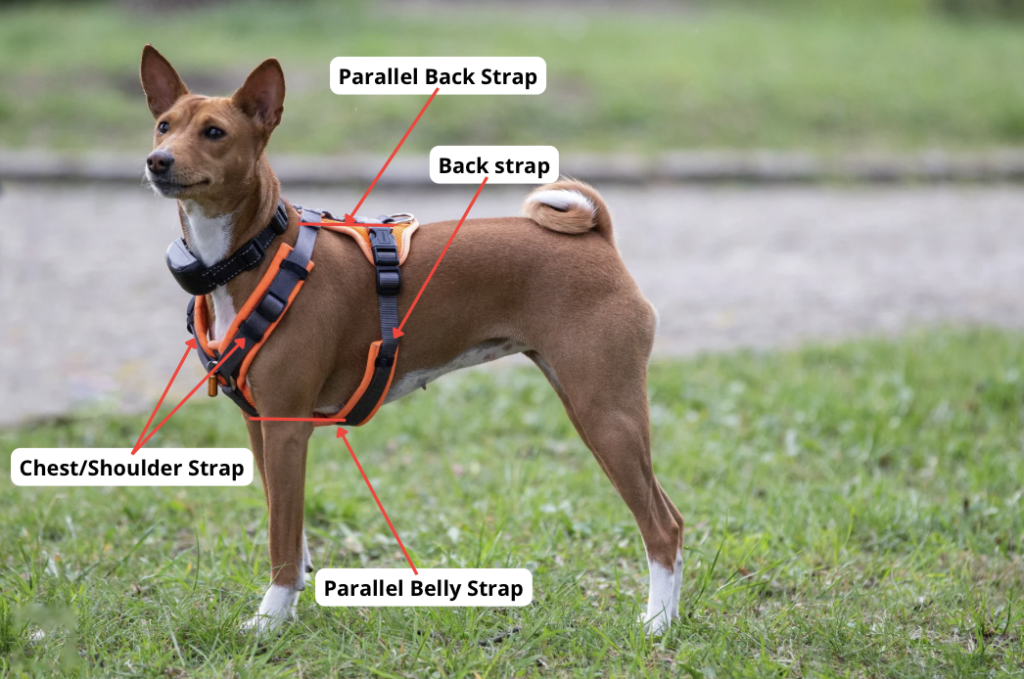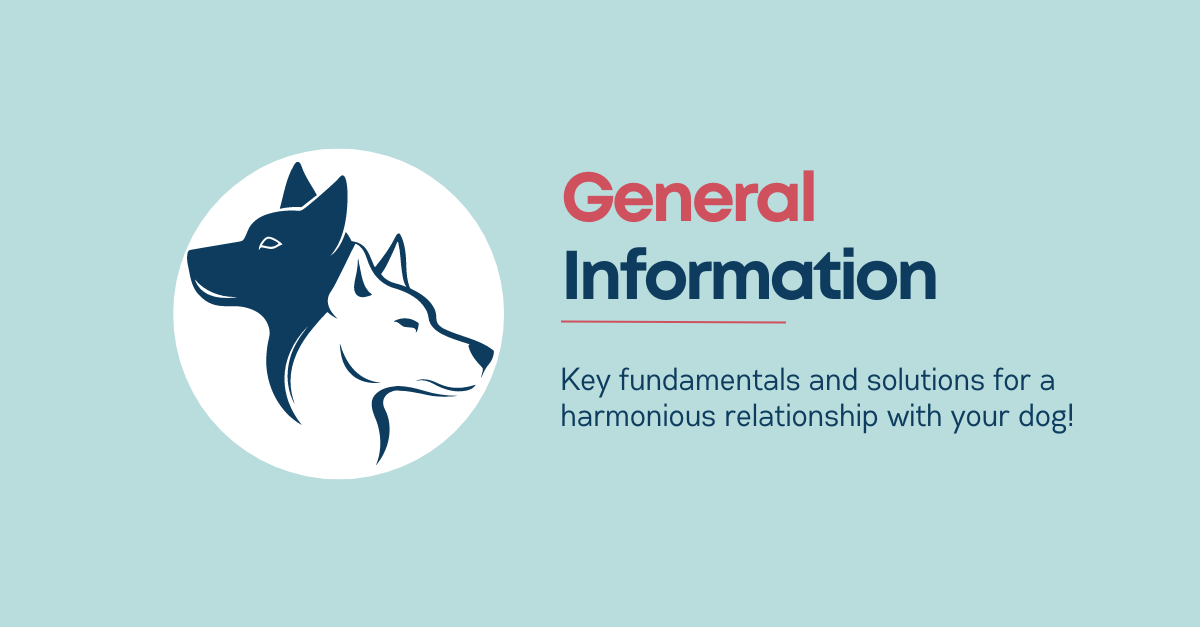When buying a dog harness, understanding the different types and how they fit is essential for both comfort and functionality. A well-chosen harness not only enhances control but also supports your dog’s well-being during walks. This guide will help you navigate the various types of dog harnesses and how to choose the right one for your dog. Whether you’re looking at different dog harness styles or figuring out how to choose the right harness for your puppy, we’ll provide you with the insights you need to make an informed decision. Learn how to choose the right size dog harness and what to consider when buying a harness, ensuring a perfect fit and optimal comfort for your furry friend.
Understanding Dog Harnesses: What They Do & Why They Matter
Harnesses provide numerous advantages over traditional collars, enhancing both your dog’s comfort and your control. Unlike a collar, which only directs your dog’s movement, a harness is designed to distribute pulling force evenly across their body. This helps in reducing strain and preventing injury. Understanding what a dog harness is and what it does is key to selecting the right type. With various dog harnesses available, it’s essential to choose one that aligns with your dog’s needs and improves their overall well-being.
Exploring Different Types of Harnesses
When choosing a harness, it’s crucial to understand the different types of harnesses for dogs and their specific benefits. Knowing the various harness types and how to put them on, as well as the differences between different dog harness styles, will help you select the best option for your pet. By exploring the different types of harnesses for dogs, you can make an informed decision that ensures both comfort and functionality for your furry friend.
- Y-Harness: The Y-shaped strap configuration of this harness helps distribute the pulling force across the chest and shoulders. Known for its comfort and even load distribution, the Y-harness is a versatile choice for many dogs.

- H-Harness: Featuring an H-shaped design, this harness provides a snug fit and stability. It is ideal for dogs that need a secure harness that remains in place during walks.

- No-Pull Harness: Designed to deter pulling by applying pressure to the chest, this harness can lead to uneven force distribution. This design may be detrimental to your dog’s health, potentially causing discomfort or injury.

- Step-In Harness: This harness requires dogs to step into it, and can be a finicky process. If your dog can be trained to wear it easily, it can be a comfortable fit with load distribution managed through the shoulder, back, and belly straps.
Front vs. Back Clip Harnesses
The type of clip on a harness can significantly influence both its stability and comfort. Understanding the different harness types for dogs, including how the clip affects the distribution of pulling force, helps you choose the right one for your pet. The clip placement varies across different dog harness styles, and knowing how to choose the right type of clip can enhance the effectiveness and comfort of the harness.
- Front Clip Harness: While this design helps manage pulling by redirecting the dog’s movement, it can offer less stability. The pressure is concentrated on the chest, which may lead to uneven force distribution and potential behavioral issues.

- Back Clip Harness: This type provides greater stability and distributes the pulling force more evenly across the back. Positioning the clip towards the rear helps distribute the load more effectively, making it a preferred choice for dogs that pull.

Key Considerations for Selecting a Harness
Choosing the right harness for your dog involves several critical factors. To make an informed decision, it’s essential to understand how to buy a dog harness that fits well and meets your dog’s needs. This includes exploring different dog harness types and how to put them on correctly. Consider how the harness fits, how to choose the right size, and the specific requirements for different dog breeds and activities. A comprehensive dog harness guide will help you navigate these options, ensuring you select the best harness for comfort and functionality, and avoid issues such as harness chafing or rubbing off fur.
- Fit: A properly fitted harness is essential to prevent chafing and ensure comfort. It should be snug but not restrictive, allowing your dog to move freely.
- Adjustability: Opt for harnesses with multiple adjustment points. This feature allows you to accommodate changes in your dog’s size and ensure a precise fit.
- Force Distribution: The harness should distribute pulling force evenly to avoid health issues and enhance your dog’s comfort during walks.
- Durability: For active or working dogs, durability is crucial. Select a harness made from strong materials that can withstand rigorous use.
- Additional Features: Consider harnesses with padding, handles, or other features that add to comfort and control. Padding helps prevent chafing, while a handle offers additional control in challenging situations.
Anatomy of a Dog Harness
Understanding the different parts of a harness and their functions can help you choose the right one:
- Chest Strap: Found in Y-harnesses, this strap helps distribute the load across the chest.
- Shoulder Strap: Also common in Y-harnesses, this strap aids in even load distribution.
- Back Strap: Provides additional support and helps distribute the load to the back.
- Belly Strap: Offers extra support and helps distribute the load to the belly, enhancing overall comfort.

How to Fit a Dog Harness
Fitting a harness correctly is essential for both comfort and safety. To achieve the proper dog harness fit, you need to know how to measure your dog for a harness accurately. This involves measuring your dog’s chest, neck, and overall body to determine the right size harness. Whether you’re fitting a puppy harness or adjusting one for an adult dog, ensuring a proper fit is crucial. The harness should be snug but not too tight, allowing for two fingers of space. Properly fitting a dog harness prevents issues such as harness chafing or discomfort. By following these steps and using a reliable guide on how to fit a harness, you can ensure your dog’s harness fits well and meets their needs.
- Measurement Areas: Measure your dog around the underarm, neck, chest, belly (if applicable), and back (if applicable). Ensure a 2-finger gap to guarantee a proper fit. This is crucial for determining how to measure for a dog harness accurately.
- Adjustability: Use the harness’s adjustable features to fine-tune the fit. It should be snug but not too tight, allowing for comfort and freedom of movement. This ensures that the harness fits properly and avoids discomfort.
- Body Type Considerations: Dogs with prominent shoulders or deeper chests require harnesses that distribute pressure evenly. Ensure the harness does not apply uneven pressure on these areas to prevent issues such as harness chafing or discomfort. Properly fitting a dog harness involves selecting one that accommodates your dog’s unique body shape for optimal comfort.
See an example below of two dogs with very different chest depths (This would require different anchor points for the harness for maximum stability):
For more details on how to ensure a right harness fit, check out our harness fitting guide!
How to Measure Your Dog for a Harness
Measuring your dog accurately is crucial for finding the right harness. To ensure a proper fit, measure your dog around key areas such as the underarm, neck, chest, belly (if applicable), and back (if applicable). A 2-finger gap should be maintained to ensure the dog harness fits correctly without being too tight or too loose. Adjustability is key, so use the harness’s adjustable features to refine the fit. This process is essential for both fitting a puppy harness and adult dog harnesses. Proper measurement and adjustment help prevent issues like harness chafing and ensure a comfortable, properly fitting harness that suits your dog’s body shape and size. More details are available in our harness fitting guide!
- Height Measurement
- Starting Point: Measure from the ground to the top of the dog’s shoulders (withers). This is the highest point of the shoulders where they meet the neck.
- Ending Point: The measurement ends at the highest point of the shoulders.
- Note: Ensure your dog is standing straight and on a flat surface for accuracy.
- Length Measurement
- Starting Point: Measure from the base of the neck (where the neck meets the shoulders) to the base of the tail.
- Ending Point: The measurement ends at the base of the tail where it connects to the body.
- Note: Use a soft tape measure and ensure the dog is in a neutral standing position.
- Chest Depth Measurement
- Starting Point: Measure from the top of the chest, just behind the front legs.
- Ending Point: Measure down to the bottom of the rib cage, where the chest curves upward.
- Note: Ensure the tape measure is snug but not tight, allowing for natural chest movement.
- Shoulder Prominence Measurement
- Starting Point: Measure around the shoulders where they are most prominent.
- Ending Point: The measurement ends at the point where the shoulders curve into the upper arm.
- Note: This measurement helps determine the appropriate fit around the shoulder area, which is crucial for harnesses that need to accommodate a dog’s build.
Additional Tips
To ensure your dog’s harness fits perfectly, accurate measurements are essential. Following these guidelines will help you choose a harness that provides optimal comfort and functionality tailored to your dog’s unique dimensions.
- Use a Flexible Measuring Tape: For accuracy, use a flexible, soft tape measure.
- Maintain a Natural Position: Ensure your dog is standing naturally, not sitting or lying down.
- Ask for Help if Needed: Having another person to assist with holding the dog and the tape measure can improve accuracy.
- Double-Check Measurements: For best results, measure twice and use the largest measurement if there’s any discrepancy.
This detailed approach ensures that you get accurate measurements for selecting a harness that fits comfortably and functions properly for your dog’s specific body shape and size.
FAQ
Are there different types of harnesses for different dogs?
Most harnesses can work well if fitted correctly, but it’s crucial to avoid no-pull and front-clip designs due to potential health and behavioral issues.
Are there any special harnesses for certain breeds?
Yes, sight hounds such as Greyhounds may need specialized harnesses due to their unique body structure, which makes them prone to escaping standard harnesses.
Can I use no-pull or front-clip harnesses on puppies?
No, these harnesses can negatively impact both physical and mental health in puppies by restricting their gait and causing potential injuries.
Can I use no-pull or front-clip harnesses on adult dogs?
Similarly, these harnesses can cause physical and mental health issues in adult dogs, including regression in muscle development and potential injuries.
Why do no-pull or front-clip harnesses cause behavior problems?
These harnesses use aversive techniques designed to punish the dog for pulling. This can lead to negative associations with external stimuli, potentially resulting in reactivity or aggression.
What harness should I use for super active working dogs?
For highly active working dogs, ensure a snug fit with a back clip positioned towards the rear. Look for harnesses with a back strap for additional load distribution, and consider features like handles and padding for extra comfort and control. Durability and robust materials are also essential.








